Montana Metal Buildings

Montana Metal Buildings
Montana Metal Buildings: Built for Harsh Winters & Versatile Use
Montana’s climate presents unique challenges, including heavy snowfall, extreme cold, strong winds, and wildfire risks. Whether you need a commercial warehouse, agricultural barn, vehicle storage, or a residential barndominium, our custom-engineered metal buildings are designed to withstand Montana’s tough weather while providing energy efficiency and durability.
Weather Considerations for Metal Buildings in Montana
1. Heavy Snow Loads & Roof Strength
- Montana experiences long, harsh winters with heavy snowfall, especially in the Rocky Mountains and western regions. Some areas see over 300 inches of snow annually.
- Metal buildings should be engineered for high snow loads, featuring:
- Reinforced roof trusses and purlins to prevent collapse.
- Steep roof pitches (4:12 or greater) to allow snow to slide off easily.
- Standing seam metal roofs, which prevent leaks and ice buildup.
- Areas like Bozeman, Helena, and Missoula require winter-ready metal structures to handle significant snow accumulation.
2. Extreme Cold & Insulation Needs
- Winter temperatures in Montana frequently drop below -30°F, especially in the eastern plains and mountain valleys.
- High-quality insulation (spray foam, fiberglass, or insulated panels) helps maintain indoor warmth and reduce heating costs.
- Thermal break technology minimizes heat loss through metal surfaces.
- Heated flooring options can be integrated for additional warmth in residential and livestock buildings.
3. High Winds & Storm Resistance
- Eastern and central Montana experience strong wind gusts of 60-100 mph, particularly in open plains and foothill areas.
- Metal buildings should be designed for wind loads of 120+ mph, featuring:
- Braced framing and reinforced anchor bolts for structural integrity.
- Hurricane-rated doors and windows to withstand strong gusts.
- Secure roofing systems to prevent wind uplift.
- Areas like Great Falls, Billings, and the eastern plains see frequent high winds, making metal structures an ideal choice.
4. Wildfire Resistance & Fire Safety
- Montana’s dry summers bring high wildfire risks, particularly in forested and rural areas.
- Non-combustible metal structures offer superior fire resistance compared to traditional wood buildings.
- Fire-resistant coatings and ember-resistant vents can be added for extra protection.
- Clearing defensible space around buildings minimizes fire spread risks in high-risk areas like Kalispell, Whitefish, and the Bitterroot Valley.
5. Seasonal Temperature Swings & Energy Efficiency
- Montana has large temperature variations, with summer highs reaching 90-100°F and winter lows below -30°F.
- Reflective metal roofing helps keep buildings cool in summer.
- Ventilation systems regulate temperature and prevent condensation in livestock and storage buildings.
- Energy-efficient insulation reduces heating and cooling costs year-round.
Why Metal Buildings Are Ideal for Montana
With Montana’s combination of harsh winters, high winds, wildfire risks, and extreme temperatures, metal buildings provide superior strength, durability, and efficiency. Whether you’re in Billings,
Missoula, Bozeman, Great Falls, or a rural part of the state, our custom-engineered metal buildings are built to handle Montana’s toughest conditions.
Would you like to add details about specific building applications (e.g., ranching, workshops, storage)?
Try Our 3D Building Designer

